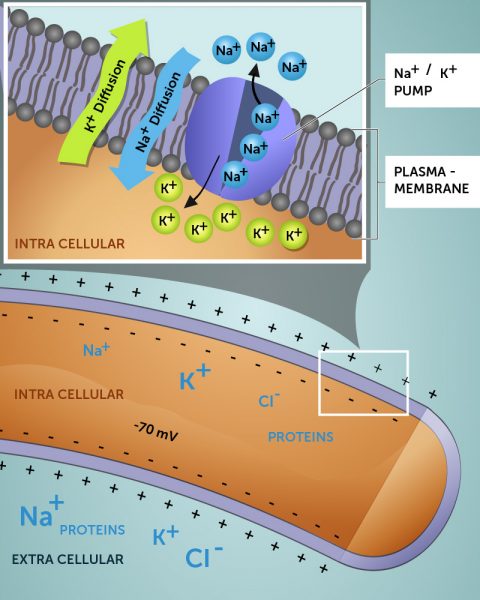Resting potential
Before we look at what happens when a neurone sends a nerve impulse, we need to consider the concept of membrane potential. Membrane potential describes the physical voltage difference between the inside and outside the cell membrane, just like the difference between the positive (+) and negative (-) poles of a battery.
There are two types of membrane potentials in cells: resting potential and action potential.
Resting potential
All cells have a resting potential. This is because the inside and outside of cells have a different distribution of positive and negative charges (Fig. 5). This is determined by the distribution of specific ions and proteins. The sodium ions (Na +) and potassium ions (K +) ions are positively charged. The chloride ion (Cl-) on the other hand has a negative charge. All proteins have an overall negative charge.
These ions and proteins are unevenly distributed between the inside and outside of cells in such a way that the intracellular side (inside), is relatively more negative than the outside of the cell, called the extracellular side (see Fig. 5).
There are three main reasons why the intracellular side is more negative than the extracellular side:
- The cell membrane contains a pump called the Na + / K + ATPase (Fig. 5) pump. This continuously pumps three sodium ions out of the cell, whilst pumping only two potassium ions back in. This represents an overall deficit of positive charge for the inside of the cell, and thus it is negative when compared with the extracellular fluid.
- The cell membrane allows some leakage of ions, but this is far greater for potassium than sodium. Both ions will be drawn to the area where there is a lower concentration, so more potassium leaks out of the cell taking its positive charge with it, meaning more positive charge accumulates outside of the cell.
- Most proteins are intracellular, and as mentioned, negatively charged so they contribute to the net negative charge inside the cell.
Overall, cells have a resting potential of -70 millivolts (mV) across their cell membrane (from inside to out).
The consequence of this is that if an ion channel for sodium opens in the cell membrane, sodium will flow into the cell by diffusion. The unequal distribution of charge will be evened out and the membrane potential increases from -70 mV to 0. An increase of membrane potential is called a depolarisation.




